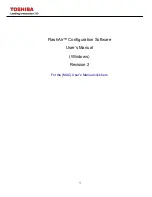
Chapter 5: MAC Address Table
94
Section I: Basic Operations
Overview
The AT-9400 Switch has a MAC address table with a storage capacity of
16,000 entries. The table stores the MAC addresses of the network nodes
connected to its ports and the port numbers where the addresses were
learned.
A switch learns the MAC addresses of the end nodes by examining the
source addresses of the packets received on a port. It adds to the MAC
table the addresses along with the ports on which the packets were
received. The result is a table of all the MAC addresses of the devices that
are connected to a switch’s ports.
When a switch receives a packet, it also examines the destination address
and, by referring to its MAC address table, determines the port where the
destination node is connected. It then forwards the packet to the
appropriate port and on to the end node. This increases network
bandwidth by limiting each frame to the appropriate port when the
destination end node is located, freeing the other switch ports for receiving
and transmitting other packets.
If a switch receives a packet with a destination address that is not in the
MAC address table, it floods the packet to all of its ports, excluding the
port where the packet was received. If the ports have been grouped into
virtual LANs, a switch floods the packet only to those ports that belong to
the same VLAN from where the packet originated. This prevents packets
from being forwarded to inappropriate LAN segments and increases
network security. When the destination node responds, a switch adds its
MAC address and port number to its MAC address table.
If a switch receives a packet with a destination address that is on the same
port on which the packet was received, it discards the packet without
forwarding it on to any port. Because both the source node and the
destination node for the packet are located on the same port on the
switch, there is no reason for the switch to forward the packet. This too
increases network performance by preventing frames from being
forwarded unnecessarily to other network devices.
The type of MAC address described above is referred to as a
dynamic
MAC address
. Dynamic MAC addresses are addresses that the switch
learns by examining the source MAC addresses of the frames received on
the ports.
Dynamic MAC addresses are not stored indefinitely in the MAC address
table. A switch deletes a dynamic MAC address from the table if it does
not receive any frames from the node after a specified period of time. A
switch assumes that the node with that MAC address is no longer active
and that its MAC address can be purged from the table. This prevents the
MAC address table from becoming filled with addresses of nodes that are
Summary of Contents for AT-S63
Page 14: ...Figures 14 ...
Page 18: ...Tables 18 ...
Page 28: ...28 Section I Basic Operations ...
Page 58: ...Chapter 1 Overview 58 ...
Page 76: ...Chapter 2 AT 9400Ts Stacks 76 Section I Basic Operations ...
Page 96: ...Chapter 5 MAC Address Table 96 Section I Basic Operations ...
Page 114: ...Chapter 8 Port Mirror 114 Section I Basic Operations ...
Page 116: ...116 Section II Advanced Operations ...
Page 146: ...Chapter 12 Access Control Lists 146 Section II Advanced Operations ...
Page 176: ...Chapter 14 Quality of Service 176 Section II Advanced Operations ...
Page 196: ...196 Section III Snooping Protocols ...
Page 204: ...Chapter 18 Multicast Listener Discovery Snooping 204 Section III Snooping Protocols ...
Page 216: ...Chapter 20 Ethernet Protection Switching Ring Snooping 216 Section III Snooping Protocols ...
Page 218: ...218 Section IV SNMPv3 ...
Page 234: ...234 Section V Spanning Tree Protocols ...
Page 268: ...268 Section VI Virtual LANs ...
Page 306: ...Chapter 27 Protected Ports VLANs 306 Section VI Virtual LANs ...
Page 320: ...320 Section VII Internet Protocol Routing ...
Page 360: ...Chapter 30 BOOTP Relay Agent 360 Section VII Routing ...
Page 370: ...Chapter 31 Virtual Router Redundancy Protocol 370 Section VII Routing ...
Page 372: ...372 Section VIII Port Security ...
Page 402: ...Chapter 33 802 1x Port based Network Access Control 402 Section VIII Port Security ...
Page 404: ...404 Section IX Management Security ...
Page 436: ...Chapter 36 PKI Certificates and SSL 436 Section IX Management Security ...
Page 454: ...Chapter 38 TACACS and RADIUS Protocols 454 Section IX Management Security ...
Page 462: ...Chapter 39 Management Access Control List 462 Section IX Management Security ...
Page 532: ...Appendix D MIB Objects 532 ...
















































